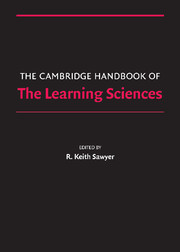Book contents
- Frontmatter
- Contents
- Preface
- Contributors
- 1 Introduction
- PART I FOUNDATIONS
- PART II METHODOLOGIES
- PART III THE NATURE OF KNOWLEDGE
- PART IV MAKING KNOWLEDGE VISIBLE
- PART V LEARNING TOGETHER
- PART VI LEARNING ENVIRONMENTS
- 28 Motivation and Cognitive Engagement in Learning Environments
- 29 Learning as a Cultural Process
- 30 Prospects for Transforming Schools with Technology- Supported Assessment
- 31 Internet Use in Schools
- 32 Teacher Learning Research and the Learning Sciences
- 33 Scaling Up
- 34 Conclusion
- Afterword: After How Comes What
- Epilogue: The Fundamental Issue in the Learning Sciences
- Author Index
- Subject Index
- References
30 - Prospects for Transforming Schools with Technology- Supported Assessment
Published online by Cambridge University Press: 05 June 2012
- Frontmatter
- Contents
- Preface
- Contributors
- 1 Introduction
- PART I FOUNDATIONS
- PART II METHODOLOGIES
- PART III THE NATURE OF KNOWLEDGE
- PART IV MAKING KNOWLEDGE VISIBLE
- PART V LEARNING TOGETHER
- PART VI LEARNING ENVIRONMENTS
- 28 Motivation and Cognitive Engagement in Learning Environments
- 29 Learning as a Cultural Process
- 30 Prospects for Transforming Schools with Technology- Supported Assessment
- 31 Internet Use in Schools
- 32 Teacher Learning Research and the Learning Sciences
- 33 Scaling Up
- 34 Conclusion
- Afterword: After How Comes What
- Epilogue: The Fundamental Issue in the Learning Sciences
- Author Index
- Subject Index
- References
Summary
The last two decades have been marked by great expectations – and some important progress – in bringing technology to bear on the process of schooling. True, the more dramatic predictions of two decades ago concerning the impact of Information Age technology on schooling (see for example, Milken Family Foundation, 1999; Office of Technology Assessment, 1995) have not come to pass. But even so, the cup is half full. Today the average student:computer ratio is 5:1 in American schools (National Center for Education Statistics, 2003), and the use of technology for student research and report preparation has become commonplace. But arguably the biggest “buzz” in the educational technology community today is around the use of technology to improve assessment. School reformers, technology enthusiasts, and business interests have all identified assessment as an area with great potential for increased classroom use of technology (Bennett, 2002; CEO Forum on Education and Technology, 2001; CoSN, 2005; Education Week, 2003).
Although enthusiasm for a marriage of classroom assessment and technology is widespread, there are two competing visions of the purpose and nature of effective classroom assessments, each with different implications for the role of technology. One vision calls for connecting classroom assessment practices more closely to state-mandated content standards and accountability systems. The other vision, which draws heavily on recent advances in the learning sciences, calls for using technology to develop and deliver assessments that are integrated into day-to-day instruction and that enable teachers to gain deeper insights into their students' thinking and to adapt their instruction accordingly.
- Type
- Chapter
- Information
- The Cambridge Handbook of the Learning Sciences , pp. 505 - 520Publisher: Cambridge University PressPrint publication year: 2005



